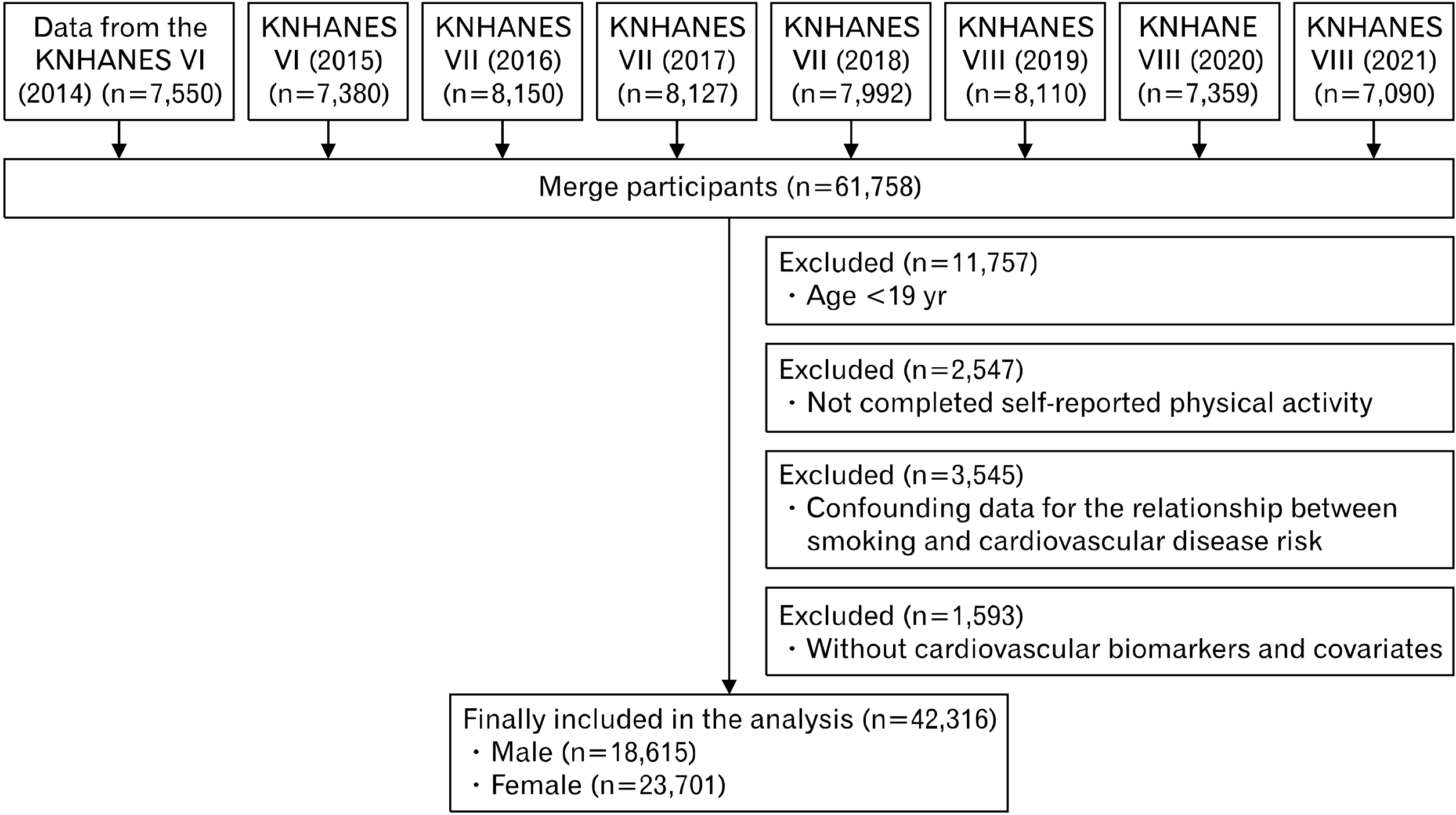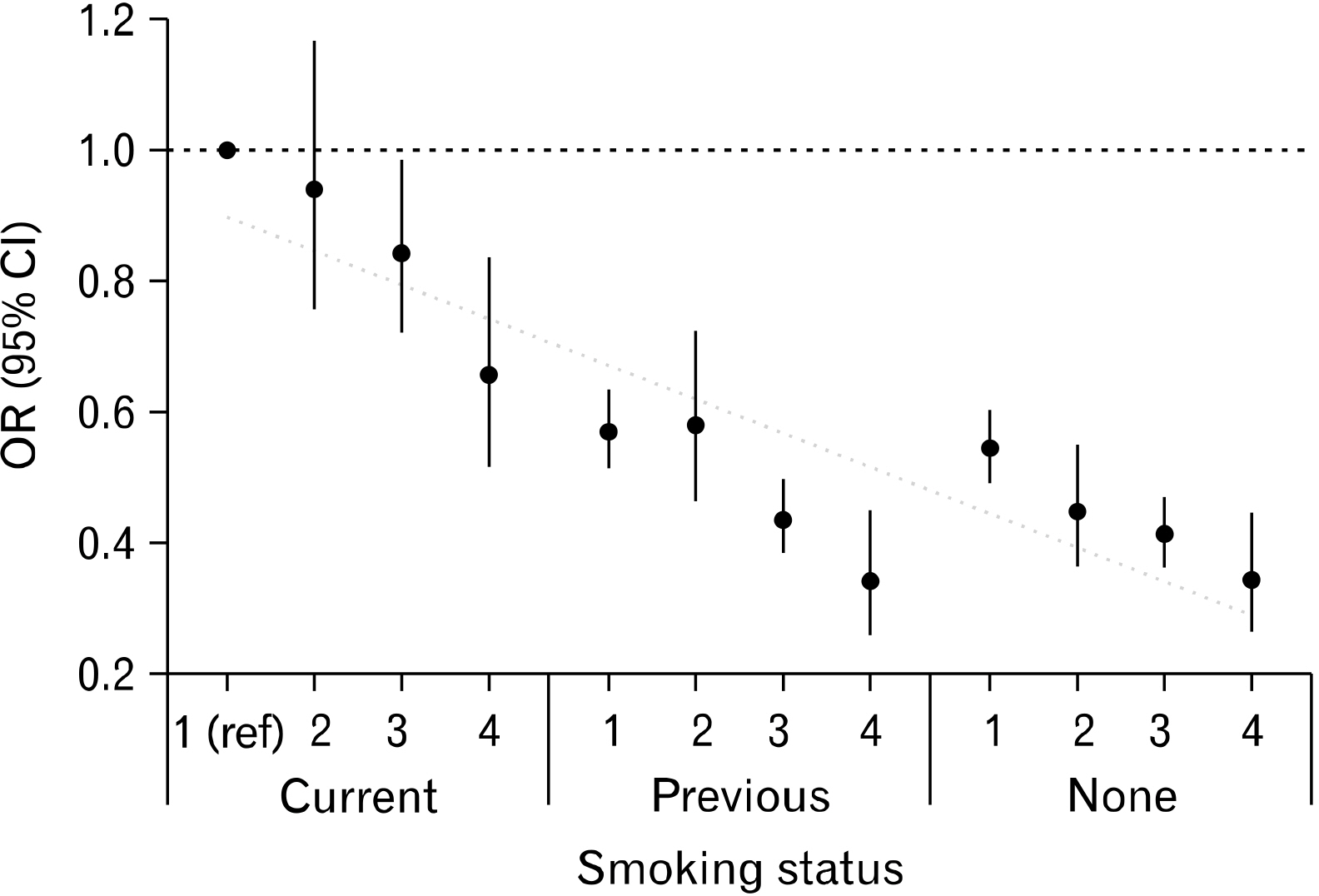Korean J Sports Med.
2024 Sep;42(3):220-228. 10.5763/kjsm.2024.42.3.220.
Association between Smoking Status, Adherence to Physical Activity Guidelines, and the Atherogenic Index of Plasma in Korean Adults: A Cross-Sectional Study
- Affiliations
-
- 1Department of Physical Education, College of Education, Seoul National University, Seoul, Korea
- 2Institute of Sport Science, Seoul National University, Seoul, Korea
- KMID: 2558670
- DOI: http://doi.org/10.5763/kjsm.2024.42.3.220
Abstract
- Purpose
The purpose of this study is to understand the association between smoking status and adherence to physical activity (PA) guidelines among Korean adults, and the atherogenic index of plasma (AIP).
Methods
The data from the Korea National Health and Nutrition Examination Survey from 2014 to 2021. When analyzing the effects of smoking and PA on the AIP, smoking status was classified as nonsmoker, former smoker, and current smoker. Meeting the PA guidelines was categorized as not meeting both the moderate-to-vigorous PA (MVPA) and muscle-strengthening activity (MSA) guidelines, meeting only the MVPA guidelines, meeting only the MSA guidelines, and meeting both. Logistic regression analysis was used to calculate the odds ratio (OR) and 95% confidence interval (CI) to determine the correlation between smoking status and AIP, whether PA guidelines were met and AIP, and the cross-effects.
Results
The risk of AIP was about twice as high in current smokers (OR, 2.00; 95% CI, 1.87–2.14) compared to those who had never smoked. When conducting multiple logistic regression analysis using current smokers who met neither the MVPA nor MSA guidelines as the reference group, the risk of AIP was found to decrease in current smokers who met only the MSA guideline (OR, 0.84; 95% CI, 0.72–0.98) or both guidelines (OR, 0.66; 95% CI, 0.51–0.84).
Conclusion
For the prevention of cardiovascular diseases, it is important to engage in both aerobic and strength exercises that meet the PA guidelines, as well as to quit smoking. PA is thought to be able to buffer the effects of smoking.
Keyword
Figure
Reference
-
1. Magnussen C, Ojeda FM, et al. Global Cardiovascular Risk Consortium. 2023; Global effect of modifiable risk factors on cardiovascular disease and mortality. N Engl J Med. 389:1273–85. DOI: 10.1056/NEJMoa2206916. PMID: 37632466. PMCID: PMC10589462.2. Joseph P, Leong D, McKee M, et al. 2017; Reducing the global burden of cardiovascular disease, part 1: the epidemiology and risk factors. Circ Res. 121:677–94. DOI: 10.1161/CIRCRESAHA.117.308903. PMID: 28860318.3. WHO CVD Risk Chart Working Group. 2019; World Health Organization cardiovascular disease risk charts: revised models to estimate risk in 21 global regions. Lancet Glob Health. 7:e1332–45. DOI: 10.1016/S2214-109X(19)30318-3. PMID: 31488387. PMCID: PMC7025029.4. Statistics Korea. Annual report on the cause of death statistics: nationwide. 2022. Statistics Korea;2023.5. Li YW, Kao TW, Chang PK, Chen WL, Wu LW. 2021; Atherogenic index of plasma as predictors for metabolic syndrome, hypertension and diabetes mellitus in Taiwan citizens: a 9-year longitudinal study. Sci Rep. 11:9900. DOI: 10.1038/s41598-021-89307-z. PMID: 33972652. PMCID: PMC8110777.6. Wu TT, Gao Y, Zheng YY, Ma YT, Xie X. 2018; Atherogenic index of plasma (AIP): a novel predictive indicator for the coronary artery disease in postmenopausal women. Lipids Health Dis. 17:197. DOI: 10.1186/s12944-018-0828-z. PMID: 30134981. PMCID: PMC6106932.7. Cai G, Shi G, Xue S, Lu W. 2017; The atherogenic index of plasma is a strong and independent predictor for coronary artery disease in the Chinese Han population. Medicine (Baltimore). 96:e8058. DOI: 10.1097/MD.0000000000008058. PMID: 28906400. PMCID: PMC5604669.8. Hammam N, Abdel-Wahab N, Gheita TA. 2021; Atherogenic index of plasma in women with rheumatoid arthritis and systemic lupus erythematosus: a 10-year potential predictor of cardiovascular disease. Curr Rheumatol Rev. 17:122–30. DOI: 10.2174/1573397116666201007123403. PMID: 33030132.9. Kraus WE, Powell KE, Haskell WL, et al. 2019; Physical activity, all-cause and cardiovascular mortality, and cardiovascular disease. Med Sci Sports Exerc. 51:1270–81. DOI: 10.1249/MSS.0000000000001939. PMID: 31095084. PMCID: PMC6527136.10. Lear SA, Hu W, Rangarajan S, et al. 2017; The effect of physical activity on mortality and cardiovascular disease in 130 000 people from 17 high-income, middle-income, and low-income countries: the PURE study. Lancet. 390:2643–54. DOI: 10.1016/S0140-6736(17)31634-3. PMID: 28943267.11. Wahid A, Manek N, Nichols M, et al. 2016; Quantifying the association between physical activity and cardiovascular disease and diabetes: a systematic review and meta-analysis. J Am Heart Assoc. 5:e002495. DOI: 10.1161/JAHA.115.002495. PMID: 27628572. PMCID: PMC5079002.12. Edwards M, Loprinzi P. 2019; The dose-response association between reported moderate to vigorous intensity physical activity and atherogenic index of plasma: NHANES, 1999-2006. J Phys Act Health. 16:368–70. DOI: 10.1123/jpah.2016-0389. PMID: 30920346.13. Edwards MK, Loprinzi PD. 2016; The association between muscle strengthening activities and atherogenic index of plasma. Prev Med. 91:318–21. DOI: 10.1016/j.ypmed.2016.09.013. PMID: 27616652.14. Lim JJ, Hei Y, Kim YS. 2022; Association of aerobic and muscle-strengthening activities with AIP in Korean adults: Korea National Health and Nutrition Examination Survey 2014-2019. J Korean Assoc Phys Educ Sport Girls Women. 36:245–58. DOI: 10.16915/jkapesgw.2022.9.36.3.245.15. World Health Organization (WHO). 2012. WHO global report: mortality attributable to tobacco [Internet]. WHO;Available from: https://www.who.int/publications/i/item/9789241564434. cited 2024 Apr 2.16. Gallucci G, Tartarone A, Lerose R, Lalinga AV, Capobianco AM. 2020; Cardiovascular risk of smoking and benefits of smoking cessation. J Thorac Dis. 12:3866–76. DOI: 10.21037/jtd.2020.02.47. PMID: 32802468. PMCID: PMC7399440.17. Duncan MS, Freiberg MS, Greevy RA Jr, Kundu S, Vasan RS, Tindle HA. 2019; Association of smoking cessation with subsequent risk of cardiovascular disease. JAMA. 322:642–50. DOI: 10.1001/jama.2019.10298. PMID: 31429895. PMCID: PMC6704757.18. Heydari G, Hosseini M, Yousefifard M, Asady H, Baikpour M, Barat A. 2015; Smoking and physical activity in healthy adults: a cross-sectional study in Tehran. Tanaffos. 14:238–45. PMID: 27114725. PMCID: PMC4841990.19. Korea Disease Control and Prevention Agency (KDCA). 2023. Korea National Health and Nutrition Examination Survey: Key results [Internet]. KDCA;Available from: https://knhanes.kdca.go.kr/knhanes/sub01/sub01_05.do. cited 2023 Jun 10.20. World Health Organization (WHO). 2021. Global physical activity questionnaire (GPAQ) [Internet]. WHO;Available from: https://www.who.int/publications/m/item/global-physical-activity-questionnaire. cited 2023 Jun 20.21. Ministry of Health and Welfare. Physical activity guidelines for Koreans. Korean Health Promotion Institute;2023.22. Mora S, Cook N, Buring JE, Ridker PM, Lee IM. 2007; Physical activity and reduced risk of cardiovascular events: potential mediating mechanisms. Circulation. 116:2110–8. DOI: 10.1161/CIRCULATIONAHA.107.729939. PMID: 17967770. PMCID: PMC2117381.23. Manson JE, Greenland P, LaCroix AZ, et al. 2002; Walking compared with vigorous exercise for the prevention of cardiovascular events in women. N Engl J Med. 347:716–25. DOI: 10.1056/NEJMoa021067. PMID: 12213942.24. Lim JO, Yang HS, Choi SE, Kim WN. 2015; Cigarette smoking and risk of cardiovascular and lung disease in Korea: a cross-sectional survey data analysis. J Korean Data Anal Soc. 17:3131–40.25. Schroeder EC, Franke WD, Sharp RL, Lee DC. 2019; Comparative effectiveness of aerobic, resistance, and combined training on cardiovascular disease risk factors: a randomized controlled trial. PLoS One. 14:e0210292. DOI: 10.1371/journal.pone.0210292. PMID: 30615666. PMCID: PMC6322789.26. Ho SS, Dhaliwal SS, Hills AP, Pal S. 2012; The effect of 12 weeks of aerobic, resistance or combination exercise training on cardiovascular risk factors in the overweight and obese in a randomized trial. BMC Public Health. 12:704. DOI: 10.1186/1471-2458-12-704. PMID: 23006411. PMCID: PMC3487794.27. Bennie JA, Ding D, Khan A, Stamatakis E, Biddle SJ, Kim J. 2020; Run, lift, or both?: associations between concurrent aerobic-muscle strengthening exercise with adverse cardiometabolic biomarkers among Korean adults. Eur J Prev Cardiol. 27:738–48. DOI: 10.1177/2047487318817899. PMID: 30861691.28. Yang Y, Xu H, Liu X, et al. 2022; Joint association of smoking and physical activity with mortality in elderly hypertensive patients: a Chinese population-based cohort study in 2007-2018. Front Public Health. 10:1005260. DOI: 10.3389/fpubh.2022.1005260. PMID: 36249230. PMCID: PMC9558130.29. Lallukka T, Lahti J, Lahelma E, Rahkonen O. 2016; The contribution of smoking to mortality during working age at different levels of leisure-time physical activity. Eur J Public Health. 26:826–30. DOI: 10.1093/eurpub/ckw065. PMID: 27161910.
- Full Text Links
- Actions
-
Cited
- CITED
-
- Close
- Share
- Similar articles
-
- Association between Physical Activity Types and Mental Health in Korean Adults: Korea National Health and Nutrition Examination Survey, 2014–2018
- Relationship between Weekly Physical Activity Frequency and Metabolic Syndrome
- Association of Daily Sleep Duration with Obesity, Macronutrient Intake, and Physical Activity
- Associations of smoking with overall obesity, and central obesity: a cross-sectional study from the Korea National Health and Nutrition Examination Survey (2010-2013)
- Joint association of aerobic physical activity and muscle-strengthening activities with metabolic syndrome : the Korean National Health and Nutrition Examination Survey 2014-2015



